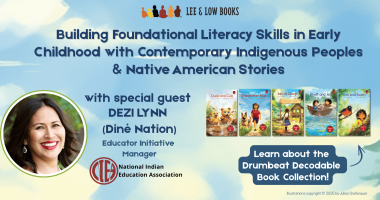Literary agents make up a big part of the publishing machine. Most publishers no longer consider unsolicited submissions, so an agent is a must if you even want to get your foot in the door. Each year, agents review many promising manuscripts and portfolios so it is safe to say they have a good sense of who makes up the talent pool of children’s book publishing. So what kind of diversity are agents seeing? Being that the number of diverse books has not increased in the last eighteen years, in order to understand why this problem persists we decided to ask the gatekeepers.
 Adriana Domínguez is an agent at Full Circle Literary, a boutique literary agency based in San Diego and New York City, offering a unique full circle approach to literary representation. The agency’s experience in book publishing includes editorial, marketing, publicity, legal, and rights, and is used to help build authors one step at a time. Full Circle works with both veteran and debut writers and artists, and has a knack for finding and developing new and diverse talent.
Adriana Domínguez is an agent at Full Circle Literary, a boutique literary agency based in San Diego and New York City, offering a unique full circle approach to literary representation. The agency’s experience in book publishing includes editorial, marketing, publicity, legal, and rights, and is used to help build authors one step at a time. Full Circle works with both veteran and debut writers and artists, and has a knack for finding and developing new and diverse talent.

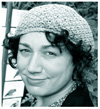 Karen Grencik and Abigail Samoun own Red Fox Literary, a boutique agency representing children’s book authors and illustrators. They offer a dazzling array of talents among their roster of clients, including New York Times and Time magazine Best Book winners, and some of the most promising up-and-coming talents working in the field today. The agency is closed to unsolicited submissions but it does accept queries from attendees at conferences where they present or through industry referrals.
Karen Grencik and Abigail Samoun own Red Fox Literary, a boutique agency representing children’s book authors and illustrators. They offer a dazzling array of talents among their roster of clients, including New York Times and Time magazine Best Book winners, and some of the most promising up-and-coming talents working in the field today. The agency is closed to unsolicited submissions but it does accept queries from attendees at conferences where they present or through industry referrals.
 Lori Nowicki is founder of Painted Words, a literary agency that represents illustrators and authors in the children’s publishing marketplace and beyond. Their goal is to provide the utmost in representation for illustrators and writers while placing a unique emphasis on developing characters, books, and licensed properties.
Lori Nowicki is founder of Painted Words, a literary agency that represents illustrators and authors in the children’s publishing marketplace and beyond. Their goal is to provide the utmost in representation for illustrators and writers while placing a unique emphasis on developing characters, books, and licensed properties.
Do you receive many submissions from authors and illustrators of color? Overall, what percentage of authors and illustrators who submit to you are people of color? Note: Estimations are fine.
AD/Full Circle: I honestly wouldn’t know about percentages, but our agency receives a good number of submissions from authors of color. Proportionally, our agency represents more authors of color than most others. Authors and illustrators who are familiar with our work and/or visit our website know that we welcome diverse points of view, and see that diversity represented in our client list. I will say that I have personally felt for a very long time that there are simply not enough illustrators of color in the marketplace, and I am not quite sure why that is. I am usually very enthusiastic when I receive a query from a talented author/illustrator of color—I wish we received more of those! As a general rule, our agency represents illustrators who are also writers, and such people are difficult to find under any circumstances, as not everyone is equally good at both.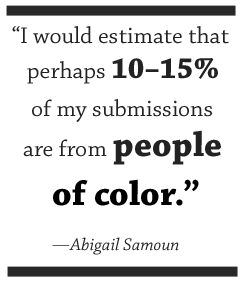
AS/Red Fox Literary: It’s hard to tell how many submissions come from authors and illustrators of color. Most of the time, I haven’t met these authors and illustrators in person so the only way for me to tell what their ethnicity might be is by their name and their choice of subjects, but these can be misleading. I once made an offer on a picture book about an African American family, told in language with a jazzy rhythm, by an author with an African American sounding name and she turned out to be a white librarian. I’d made the assumption, based on the subject and the author’s name, that she would be African American.
Oftentimes, the question of the author’s ethnicity doesn’t enter my mind—unless the subject relates to race, in which case I’ll wonder if the author will have the life experience that can provide a genuine insider’s point-of-view. I would estimate that perhaps 10–15% of my submissions are from people of color.
KG/Red Fox Literary: I have four authors of color on my list of 38 authors, but like Abi says, we never know the ethnicity of an author when they submit to us. The only way I could imagine to gauge it would be by determining how many authors of color attend an SCBWI conference at which I present, comparing that number to the total number of attendees, and then assuming the ratio of submissions to be a similar percentage. At the recent summer conference in LA, I would guesstimate that authors of color made up about 35% of the total number of attendees.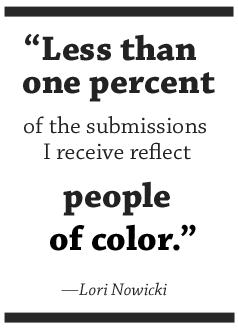
LN/Painted Words: I only review samples. Less than one percent of the submissions I receive reflect people of color in the samples.
A question specifically for Karen, Abigail and Lori: Why do you think you receive far fewer submissions from authors of color as opposed to white authors?
AS/Red Fox Literary: From what I’ve gleaned from attending conferences, it feels like a large percentage of the people writing children’s books are white women in their forties, fifties, and sixties with at least some college education. This probably has been the case for decades. The children’s book authors I’ve met often share a few characteristics: They grew up with books, they’ve read a lot, they have some sort of connection to children, either through teaching, parenting, or a job that puts them in contact with kids, and they’ve had the time and money to develop their writing skills and attend conferences. So I think there is definitely a socio-economic factor in becoming a children’s book author.
KG/Red Fox Literary: I would agree with Abi on this. Most of my authors are, or have been, school teachers or librarians throughout their careers. Most of them are married and are financially stable, which allows them the time to study the craft of writing for children. Most people who write for children do so because they want to make the world a better place in their own way, not as a vehicle to support themselves, and the return on the investment for studying the craft of writing for children is pretty pitiful. I think writing for children is a luxury that not everyone can afford.
LN/Painted Words: This seems like a question for an author to answer.
Are the books written or illustrated by authors and illustrators of color less marketable? Is there a difference between the salability of books written and illustrated by white authors as opposed to ones written and illustrated by people of color?
AD/Full Circle: You will never hear me say that books by and for some of the largest (and growing) sectors of the US population are “less marketable” than any other kind of book! I have written about this topic quite a bit lately—ever since that now infamous New York Times article surfaced late last year about the lack of Latino characters in children’s books. As I’ve said before, I think that there are some real disconnects that make selling these projects to publishers a little more difficult sometimes. But the audience is there, and growing. Latinos alone now make up more than a quarter of the public school population and we always hear from educators, librarians—and yes, even parents!—that there are not enough books written by and about children of color. I think one of the obstacles is that the world of publishing has not quite caught up with this market’s potential. Part of this is due to a lack of diversity in publishing itself.
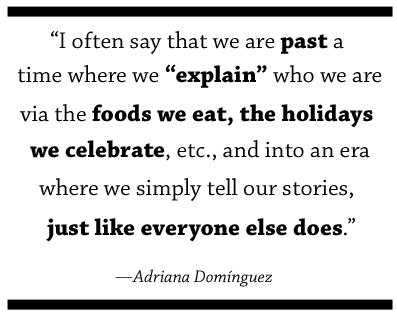 There is also the very important question of what constitutes a diverse book these days. Are we looking to publish more books that “tell” about “other” cultures and ethnicities, or should we be simply “showing” kids characters that look and act like their friends at school and at the playground? When speaking about Latino books in particular, I often say that we are past a time where we “explain” who we are via the foods we eat, the holidays we celebrate, etc., and into an era where we simply tell our stories, just like everyone else does. Why not? Why do our books have to be perceived as “different” and be unnaturally separated from the rest of children’s books? I see my three-year-old and know that he will not think of ethnicity and race the same way my generation did—and boy, am I glad! His friends span the gamut of colors and cultures, and his life will be richer for it. For me, diverse kid’s lit is not about “highlighting” Latinos or any other ethnic group, or “teaching” readers about what makes those groups different, it’s about adopting a more inclusive and authentic approach toward our children’s literature so that kids can truly see themselves—and their friends—in the books they read.
There is also the very important question of what constitutes a diverse book these days. Are we looking to publish more books that “tell” about “other” cultures and ethnicities, or should we be simply “showing” kids characters that look and act like their friends at school and at the playground? When speaking about Latino books in particular, I often say that we are past a time where we “explain” who we are via the foods we eat, the holidays we celebrate, etc., and into an era where we simply tell our stories, just like everyone else does. Why not? Why do our books have to be perceived as “different” and be unnaturally separated from the rest of children’s books? I see my three-year-old and know that he will not think of ethnicity and race the same way my generation did—and boy, am I glad! His friends span the gamut of colors and cultures, and his life will be richer for it. For me, diverse kid’s lit is not about “highlighting” Latinos or any other ethnic group, or “teaching” readers about what makes those groups different, it’s about adopting a more inclusive and authentic approach toward our children’s literature so that kids can truly see themselves—and their friends—in the books they read.
AS/Red Fox Literary: Unless a book has a racial theme, I don’t believe the author’s ethnicity makes any difference on salability, at least not when it comes to selling the project to an editor. Perhaps it makes a difference in the bookstore, but certainly not on the agent’s end of things. The author’s ethnicity, however, makes a tremendous difference when the story is told from the perspective of a person of color. Editors want those stories told by insiders to the culture. In addition, there are awards that are specifically geared to authors of certain ethnic backgrounds. Since those awards usually mean greater sales, particularly in the school and library market, publishers see it as a great benefit if those books are written by a person of color.
KG/Red Fox Literary: I would agree with Abi here.
LN/Painted Words: Books by illustrators of color are not less marketable. Making a sale depends on the subject matter and if there is an audience for the material.
The salability of an artist’s work has to do with the subject matter she or he is illustrating. An editor or art director will consider an illustrator for a book that best fits the text. The color of an illustrator’s skin rarely comes up in conversation. If it’s a book about a particular subject, then a publisher may consider an artist who has direct experience with the material. For example, one of our illustrator’s, Elizabeth Zunon, was born in the US but raised in the Ivory Coast. She uses rich colors and textures in her artwork inspired by the environment in which she grew up. This brings an authenticity to a project. Some of the books she has illustrated are set in Africa, specifically, The Boy Who Harnessed the Wind (Dial) and Lala Salama: A Tanzanian Lullaby (Candlewick). Vanessa Brantley-Newton is an African American illustrator and she loves fashion. She often incorporates her sense of fashion in her books. She was chosen by Simon & Schuster to work on Tori Spelling’s book Tallulah.
Do you do any special outreach or marketing to authors and illustrators of color?
AD/Full Circle: As an agency, we often attend writers conferences all over the country, where we keep our eyes peeled for writers of color. This past March, I was thrilled to participate in SCBWI’s Los Angeles’ annual “Writer’s Days” conference, which this year focused on diversity! It was truly inspiring to spend two entire days discussing the topic with the likes of Malinda Lo, Nikki Grimes, Eugene Yelchin, Daniel Nayeri, and all of the very enthusiastic SCBWI organizers. I truly applaud SCBWI for making the event possible. I hope to continue to see many more conferences and discussions such as this one on the topic of diversity in the future!
For my part, I participate in the Comadres and Compadres Writers Conference, which I helped launch last year along with Nora Comstock, CEO of Las Comadres para Las Americas, a nationwide Latina networking organization; editorial consultant Marcela Landres; the AAP; and the National Black Writers Conference. Comadres and Compadres represents my most personal effort to date to help Latinos get published. It’s a day-long event that takes place in the city where publishing lives and breathes, and its sole purpose is to bring together Latino authors and illustrators and members of the publishing industry who are best positioned to advise them on how to get published. I am happy to report that two of our inaugural attendees last year secured agents and one of them already has a book deal in place! This conference proves that if we make conscientious efforts to be more inclusive, and create more opportunities for writers of color, we will get results!
AS/Red Fox Literary: Nothing specific, but since I want to represent a broad range of styles and book projects so that I can cater to a broad range of publishers and editors, I try to represent clients with varied backgrounds, both in terms of their ethnicity and life experience.
KG/Red Fox Literary: I don’t do any outreach or marketing to anyone. I have a strong faith that the right projects will come to me, so I just do the very best I can with every manuscript and author I commit to. I care about the story and about the people with whom I work. Ethnicity is not a consideration when I take on a project.
LN/Painted Words: There is no specific outreach program, although one-fifth of our illustrators are of people of color. Most of the illustrators who come to our group are familiar with what we have to offer, and are looking to grow and evolve as authors and illustrators. Occasionally, an editor or art director will recommend an illustrator who is looking for representation.
Since the number of books for children written and/or illustrated by people of color has not grown in the last eighteen years according to our CCBC study, what could agents do to increase this number?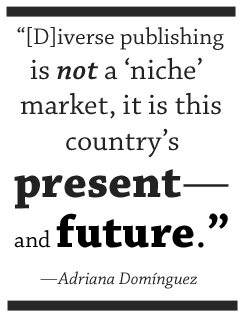
AD/Full Circle: Our agency is very open to diverse points of view and we consider those submissions very carefully. I think all agents should be aware of the growing diversity of our children, and take that into account when selecting projects to represent. We should all take a good look around at our schools and playgrounds. Seeing my son at preschool, surrounded by many other kids who are also multilingual and multicultural, and who already have a broader understanding of the world, gives me hope and confirms for me that diverse publishing is not a “niche” market, it is this country’s present—and future.
AS/Red Fox Literary: I do think reaching out to authors and illustrators of color, particularly those just starting out in the book business, is a good idea. One of my newest clients is a Mexican illustrator who I met when she was an undergraduate at an art school where I’d been asked to speak. We agents are used to clients seeking us out, but I have to remind myself that looking at art school blogs and seeking out opportunities to meet the next generation of children’s authors and illustrators can put me in contact with those whose paths might not otherwise cross my own.
KG/Red Fox Literary: I don’t think many agents are actively searching for new clients, so I can’t see how an agent could have much of an impact on this issue unless they had a personal passion for it. I am grateful to publishers like Lee & Low who devote their lives to leveling out the playing field. I think the change is going to have to come from within those who are affected, who have the energy, the passion, and the drive to effect the change, just like any underrepresented group in any profession. But since the return on the investment for the author is so low, I don’t know how many people of color are going to have the desire to climb the mountain to publication that every new author faces, or have the luxury of dedicating the time it takes to master the craft.
LN/Painted Words: Publishers are always looking for inspiring stories with strong characters who overcome challenges. I believe the challenge is finding those stories and developing them. If the story is about an existing person in history who has been written about a lot, what approach can one take to give it a unique perspective?
And last but not least, a newcomer joins the fray:
 Mira Reisberg is founder of Hummingbird Literary, which represents fiction and nonfiction artists, authors, and author/illustrators. Their goal is to facilitate getting books that touch the soul, tickle the funny bone, or expand understanding of the world, into the hands of children and young adults for all ages and cultures. We have a particular sweet spot for authors and illustrators of color but are open to anyone dedicated to their craft.
Mira Reisberg is founder of Hummingbird Literary, which represents fiction and nonfiction artists, authors, and author/illustrators. Their goal is to facilitate getting books that touch the soul, tickle the funny bone, or expand understanding of the world, into the hands of children and young adults for all ages and cultures. We have a particular sweet spot for authors and illustrators of color but are open to anyone dedicated to their craft.
Why did you decide to start Hummingbird Literary?
MR: Over the years, I have taught and mentored many successful writers and illustrators. After nine students received twelve contract offers in nine months (now eleven with fifteen offers in ten months) the beautiful Karen Grencik of Red Fox Literary and I got talking. She thought I’d make a great agent because of my passion, experience, and students’ successes and offered to mentor me. I got really excited and really scared. Karen and others encouraged me. Hummingbirds insistently came to my window. I decided to open new doors, especially to writers and illustrators of color.
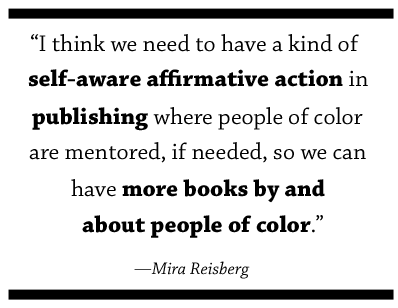 What do you hope to accomplish by moving into the agent role?
What do you hope to accomplish by moving into the agent role?
MR: I hope to continue doing good in the world through children’s literature. I want to help midwife wonderful books for all ages and cultures that bring humor, joy, beauty, and a sense of community, caring, and fairness. I think we need to have a kind of self-aware affirmative action in publishing where people of color are mentored, if need be, so we can have more books by and about people of color. We want kids of color to see themselves reflected as inspiring protagonists and as book creators themselves. Although authors and illustrators of any race, religion, sexual orientation, or ethnic background are invited to submit to Hummingbird Literary, I am offering additional assistance for authors and illustrators of color who need it, and scholarships for them at Picture Book Academy.
I am incredibly grateful that publishers like LEE & LOW BOOKS, Shen’s Books, Arte Publico, and others exist, but I do hope that these books won’t get marginalized on the “multicultural” shelf instead of being seen as wonderful literature from and for the whole fabric of American culture.







